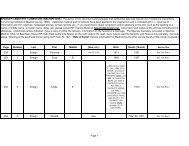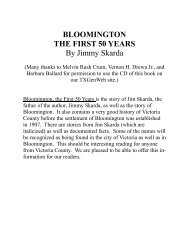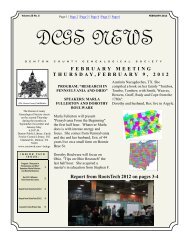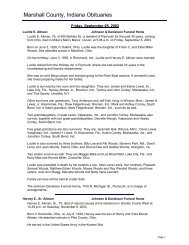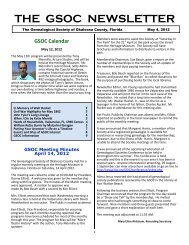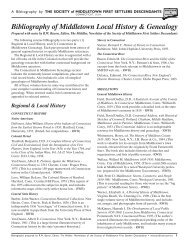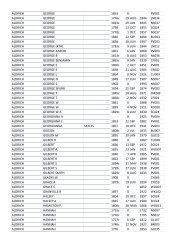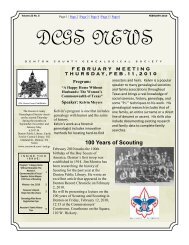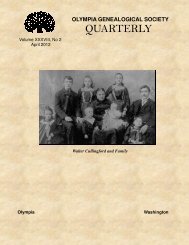June 1996 Newsletter [v5.0] - RootsWeb
June 1996 Newsletter [v5.0] - RootsWeb
June 1996 Newsletter [v5.0] - RootsWeb
You also want an ePaper? Increase the reach of your titles
YUMPU automatically turns print PDFs into web optimized ePapers that Google loves.
to Texas.<br />
The primary destination of the German Catholic<br />
emigres was the Watertown, Wisconsin area. In<br />
the early 1850s, Watertown, with about 5,000<br />
inhabitants, was one of the largest cities in<br />
Wisconsin. The area's abundant rich, rolling<br />
farmland, some of which had been partially<br />
cleared by earlier settlers, would have appealed<br />
to Landskroners wanting to farm their own land in<br />
America. Wisconsin had become a state in 1848,<br />
and southern Wisconsin was no longer considered<br />
part of the western frontier. Railroads were<br />
starting to connect the major towns in the state,<br />
and farmers were able to sell their surplus product<br />
on the market.<br />
Watertown was also a center of German<br />
immigration. As such, the Landskron emigrants<br />
would have found in the Watertown area Germanspeaking<br />
immigrants from the Austrian Empire,<br />
Bavaria, Prussia and other German-speaking<br />
lands, in addition to those Landskron-district<br />
families that had emigrated in earlier years.<br />
Watertown had a German Catholic parish (Saint<br />
Henry's) founded in 1853, a German newspaper,<br />
the Anzeiger, and a brewery.<br />
The Voyage to the New World<br />
Most of the earlier emigrants from the Landskron<br />
district departed from the port of Bremen in what<br />
is now northwestern Germany. The emigrants<br />
probably traveled by rail to Bremen. Landskroner<br />
emigrants to the American Midwest generally<br />
headed to the port of New York or to Baltimore.<br />
When they reached America, it is believed that<br />
most of the settlers took the train via Chicago to a<br />
town like Watertown, where they intended to<br />
look for land. If the rail lines had not yet reached<br />
their final destination, they would have<br />
completed their trip by coach or wagon.<br />
The first Landskroner emigrants known to have<br />
settled permanently in southern Wisconsin<br />
arrived in 1852. The records of the Jason, which<br />
arrived in New York on December 7, 1852, from<br />
Bremen, shows about sixty people from the<br />
Landskron district on board: the Johann Blaschka<br />
and Johann Klecker families of Hertersdorf<br />
(Horní Houzovec), the Ignatz Yelg, Wenzel<br />
Blaschka and Johann Blaschka families of<br />
Tschernowier (Cernovír), the Joseph Veit family<br />
and Anton Wawrauscheck, Philip Zimprich and<br />
Ludwig Zimprich of Knappendorf (Knapovec),<br />
10<br />
the Anton Fiebiger family of Jokelsdorf<br />
(Jakubovice), the Johann Fischer family of<br />
Riebnig (Rybník), the Joseph Zimprich family of<br />
Rathsdorf (Skuhrov) and the Wenzel Fuchs<br />
family of Hilbetten (Hylváty). Also on board<br />
were the following persons, whose place of origin<br />
may be the district of Landskron: the Wenzel<br />
Blaska and Anton Kobliz families, Barbara<br />
Detterer and Franz Meidner. The Jason provided<br />
the nucleus of the Landskroner community near<br />
what in 1859 became the village of Waterloo,<br />
west of Watertown, Wisconsin.<br />
On January 10, 1853, the Johanna arrived in New<br />
York from Bremen with seven families of thirtytwo<br />
people from the Landskron district: the John<br />
Huebel, Johann Langer and John Stangler families<br />
of Rudelsdorf (Rudoltice), the Franz Pirkl, Franz<br />
Haubenschild and Johann Haubenschild families<br />
of Triebitz (Trebovice), and the Josef Rössler<br />
family of Michelsdorf (Ostrov). Also on board<br />
was the Franz Gilg family of Nikl (Nikulec) in<br />
the neighboring county of Zwittau (Svitavy). A<br />
number of these families joined the Jason group<br />
near Waterloo, Wisconsin.<br />
On <strong>June</strong> 17, 1853, the Oldenburg arrived in New<br />
York from Bremen, with 103 passengers from<br />
Bohemia whose stated destination was<br />
Wisconsin. The emigrants from the district of<br />
Landskron were the following: the Johann Meitner<br />
and Johann Schöberle families, Vincenz Klecker<br />
and Franz Schöberle of Ober Johnsdorf (Horní<br />
Tresnovec), the Franz Hampel, Josef Jirschele and<br />
Josef Arnold families of Rathsdorf (Skuhrov), the<br />
Franz Langer, Ignatz Huebl, and Bernhard<br />
Leschinger families of Rudelsdorf (Rudoltice), the<br />
Franz Fischer, Johann Plotz and Engelbert<br />
Habermann families of Riebnig (Rybník), the<br />
Johann Smetana and Johann Kuckera families of<br />
Tschernowier (Cernovír), the Franz Foltin family<br />
of Königsberg (Královec), and the Anton Kristl<br />
family of Michelsdorf (Ostrov). Two other<br />
families were from neighboring districts: the<br />
Wenzel Scholla family of Prívrat (Pschiwrat)<br />
and the Joseph Pospischel family of Litomysl<br />
(Leitomischl). The other families from Bohemia<br />
were the Nicholaus Dank, Johann Czernin, Johann<br />
Strilesky, and Arnold Patsch families. The<br />
Johann Meitner, Johann Schöberle, Franz Hampel<br />
and Franz Langer families, along with Vincenz<br />
Klecker and Franz Schöberle, provided the<br />
nucleus of the Landskroner community of<br />
Watertown, Wisconsin. A number of these other


![June 1996 Newsletter [v5.0] - RootsWeb](https://img.yumpu.com/5198022/10/500x640/june-1996-newsletter-v50-rootsweb.jpg)
